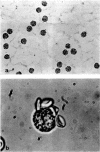Abstract
The aim of this study was to investigate the possible formation of spontaneous rosettes between human eosinophils and sheep erythrocytes. In patients with parasitic diseases a percentage of 15.7 +/- 6 (range 6-23%), eosinophils were able to form rosettes. Each rosette showed as few as four to eight erythrocytes attached per eosinophil. Two types of interaction were observed at the electron microscope: point attachments and large surface contacts. In patients with non-parasite induced eosinophilia the formation of rosettes is decidedly below the above-mentioned percentage (less than 2%) or totally absent. It follows that during parasitic infections with blood eosinophilia, whatever the mechanism responsible, the formation of spontaneous rosettes could be diagnostic significance and might reflect qualitative or quantitative modifications in the eosinophil population.
Full text
PDF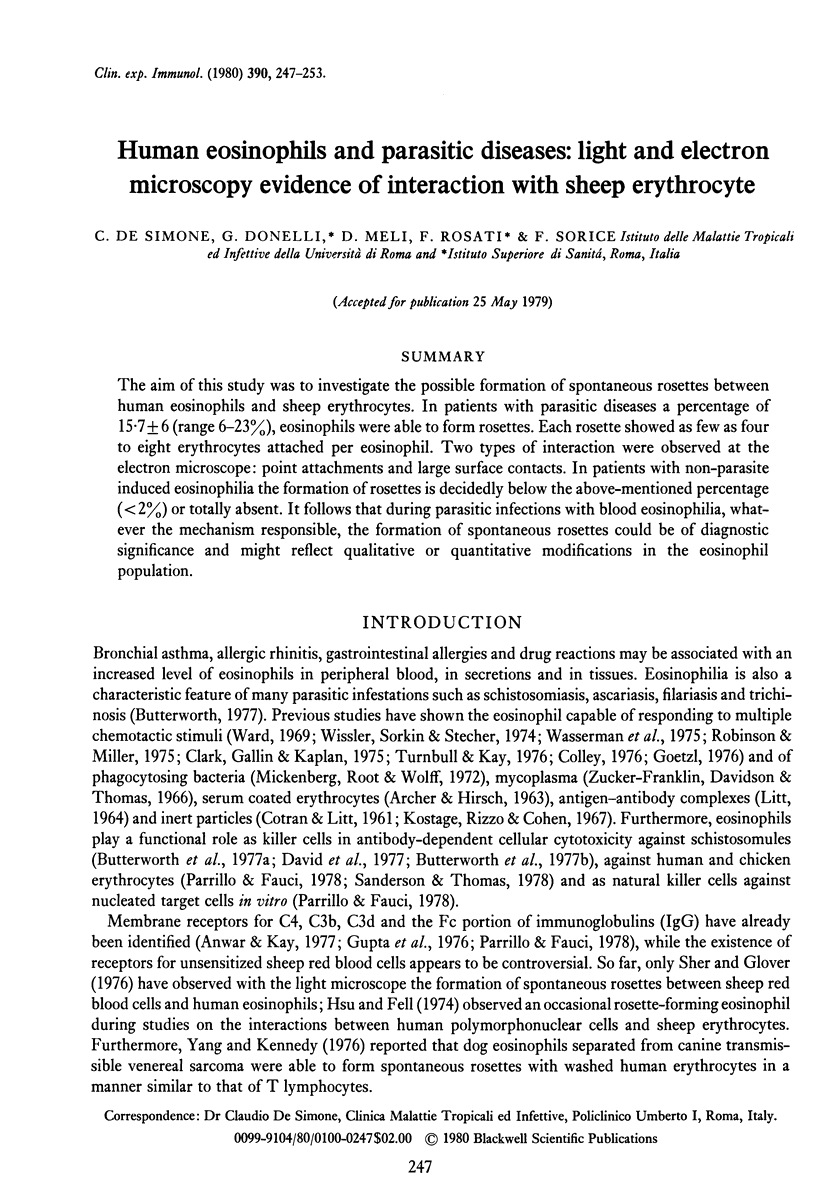
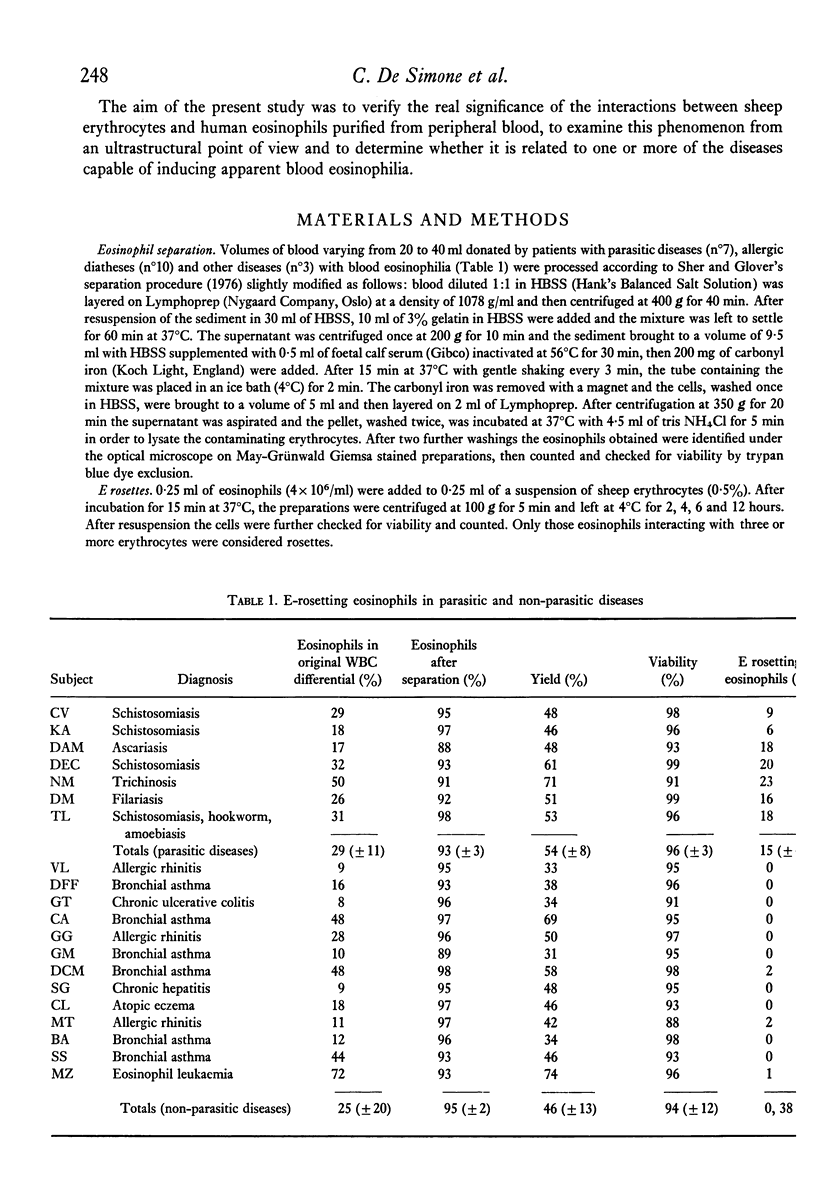
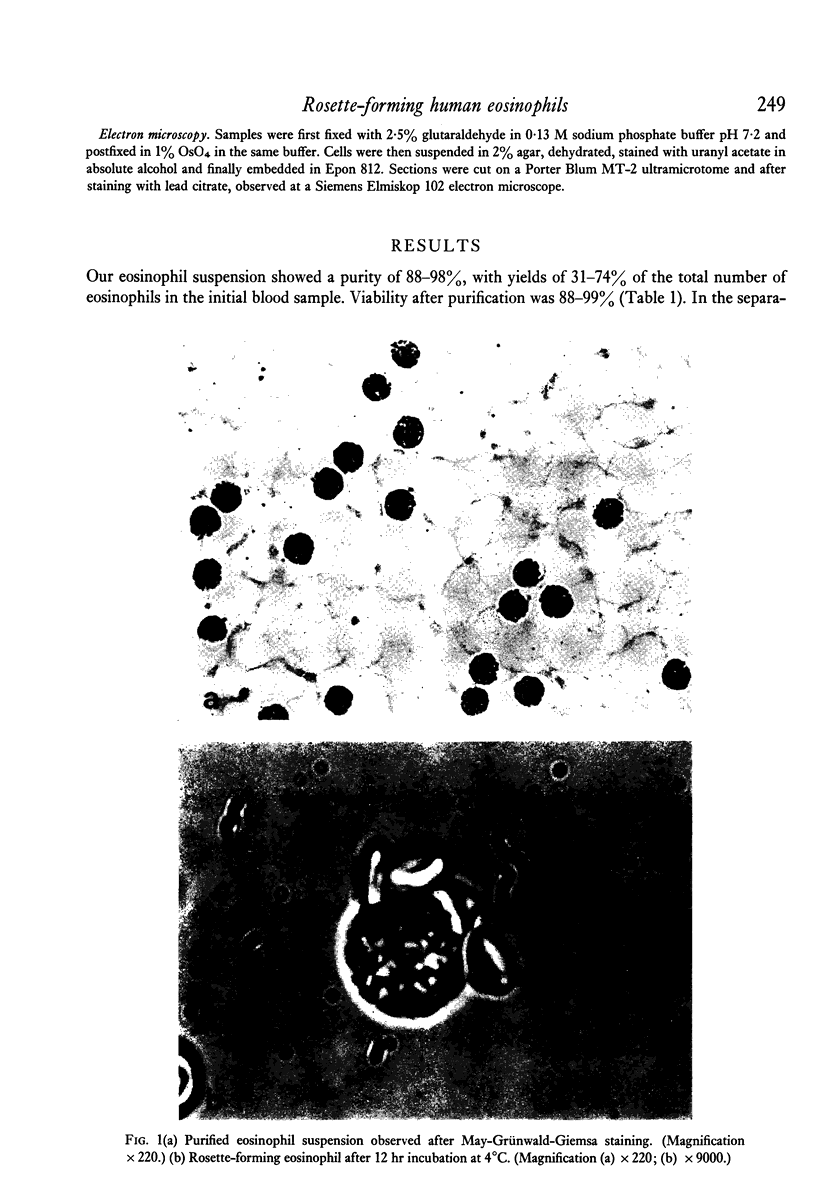
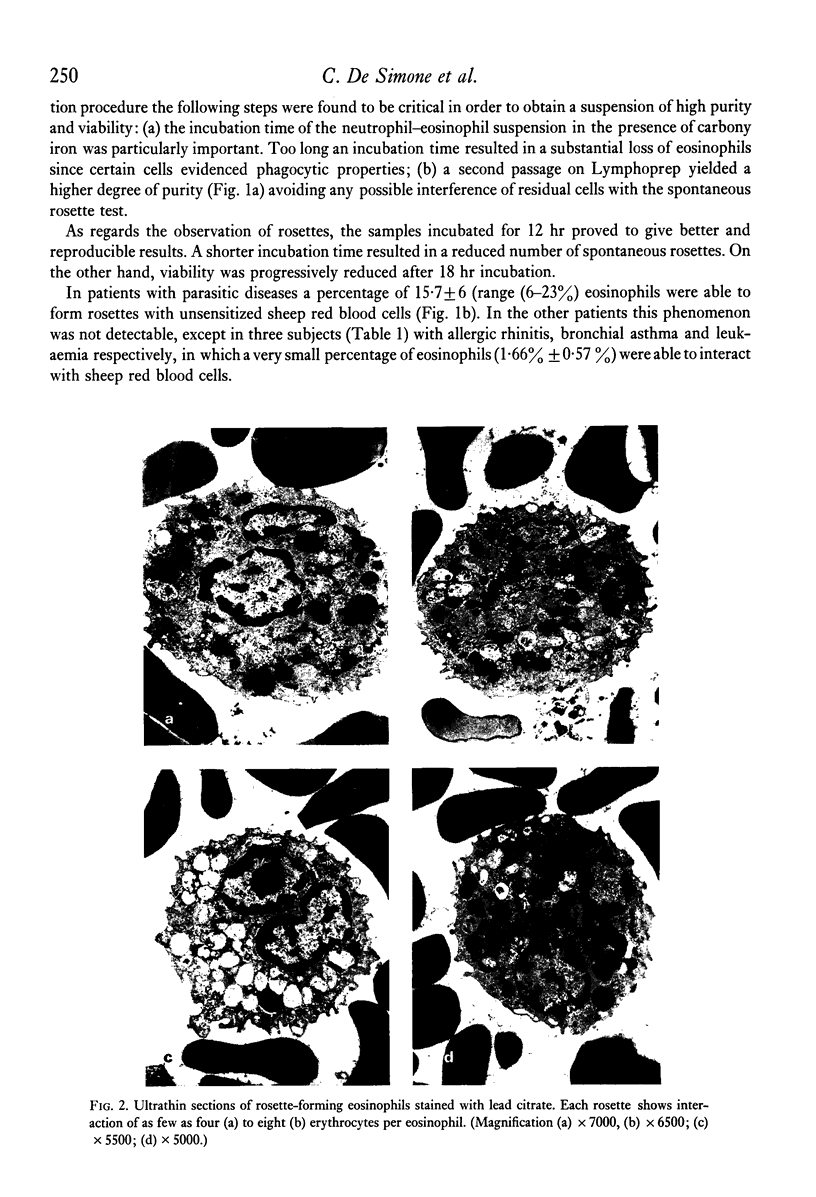
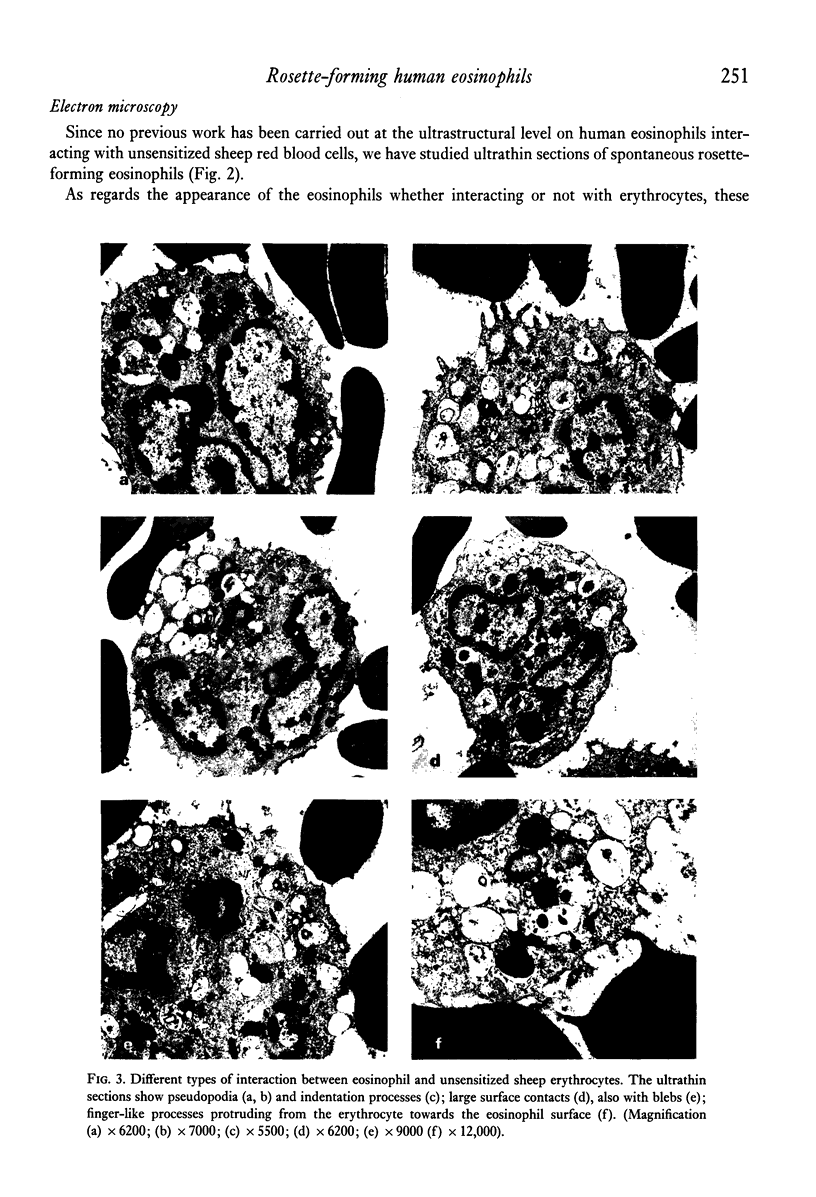
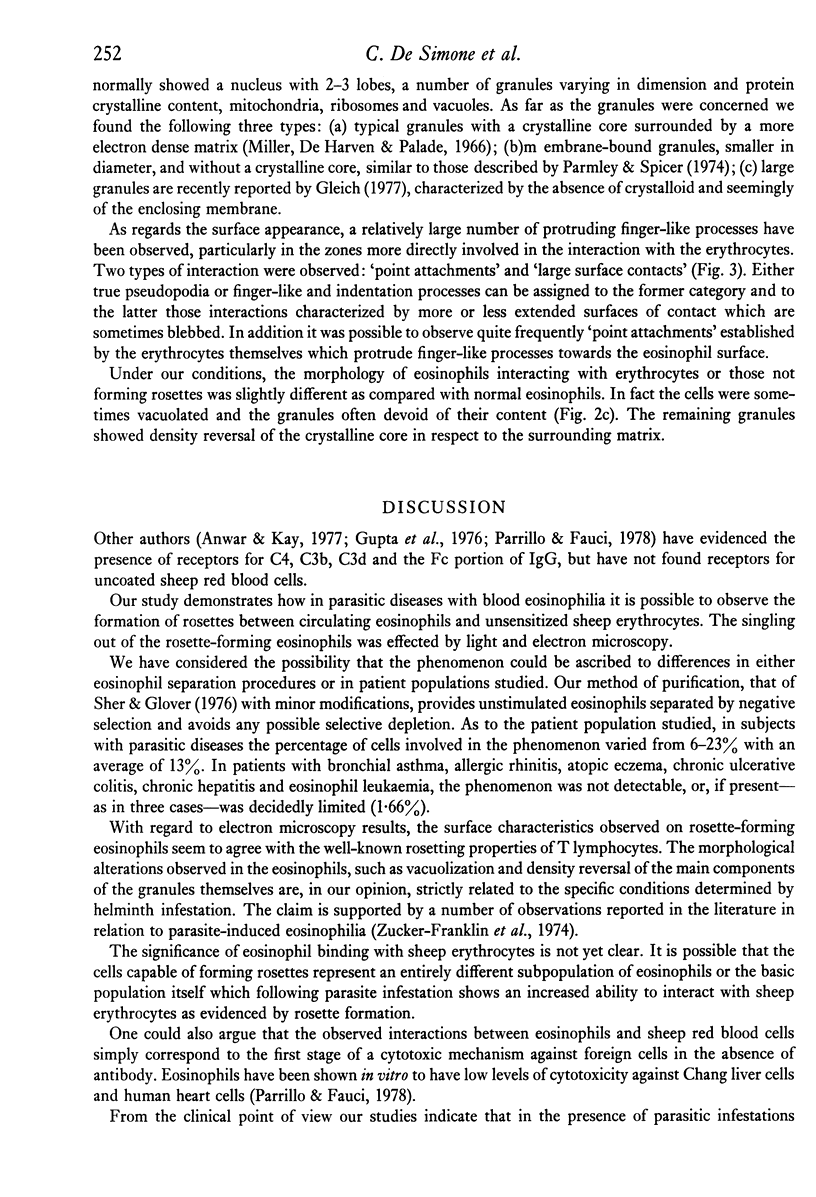
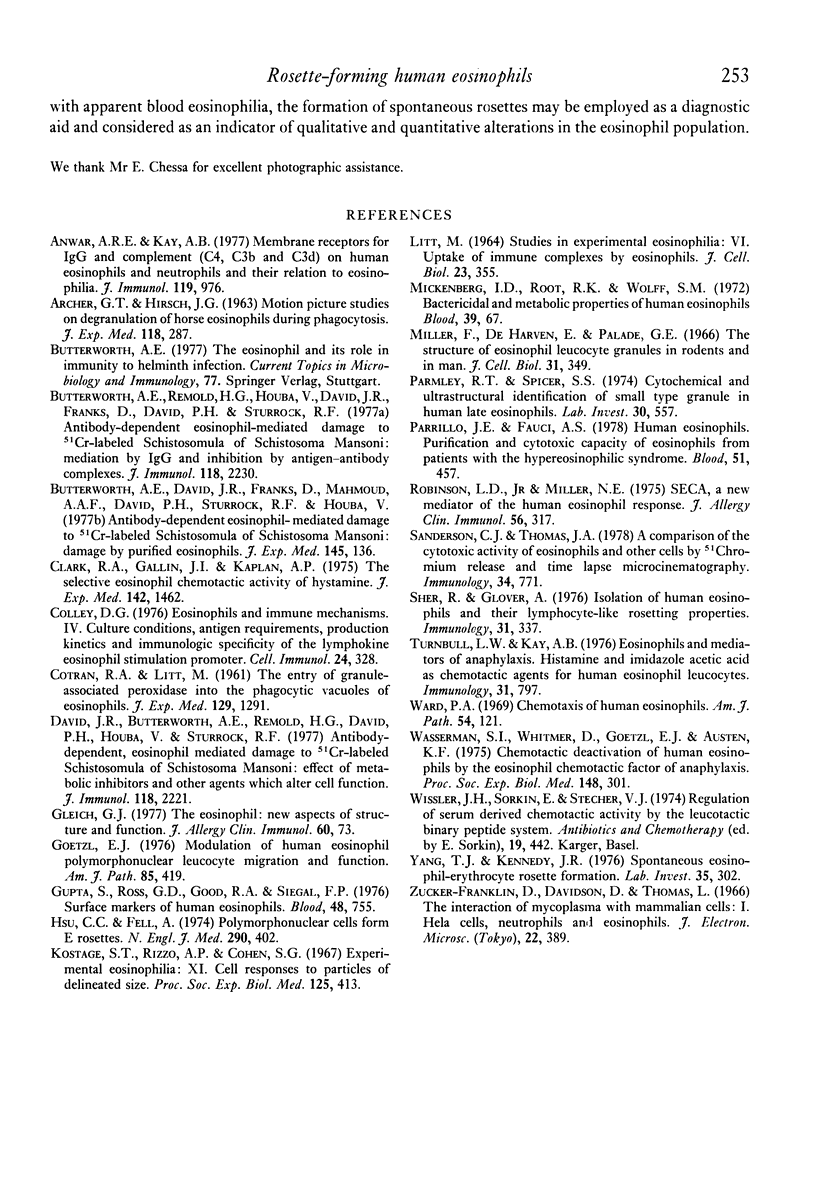
Images in this article
Selected References
These references are in PubMed. This may not be the complete list of references from this article.
- ARCHER G. T., HIRSCH J. G. MOTION PICTURE STUDIES ON DEGRANULATION OF HORSE EOSINOPHILS DURING PHAGOCYTOSIS. J Exp Med. 1963 Aug 1;118:287–294. doi: 10.1084/jem.118.2.287. [DOI] [PMC free article] [PubMed] [Google Scholar]
- Anwar A. R., Kay A. B. Membrane receptors for IgG and complement (C4, C3b and C3d) on human eosinophils and neutrophils and their relation to eosinophilia. J Immunol. 1977 Sep;119(3):976–982. [PubMed] [Google Scholar]
- Butterworth A. E., David J. R., Franks D., Mahmoud A. A., David P. H., Sturrock R. F., Houba V. Antibody-dependent eosinophil-mediated damage to 51Cr-labeled schistosomula of Schistosoma mansoni: damage by purieid eosinophils. J Exp Med. 1977 Jan 1;145(1):136–150. doi: 10.1084/jem.145.1.136. [DOI] [PMC free article] [PubMed] [Google Scholar]
- Butterworth A. E., Remold H. G., Houba V., David J. R., Franks D., David P. H., Sturrock R. F. Antibody-dependent eosinophil-mediated damage to 51Cr-labeled schistosomula of Schistosoma mansoni: mediation by IgG, and inhibition by antigen-antibody complexes. J Immunol. 1977 Jun;118(6):2230–2236. [PubMed] [Google Scholar]
- Clark R. A., Gallin J. I., Kaplan A. P. The selective eosinophil chemotactic activity of histamine. J Exp Med. 1975 Dec 1;142(6):1462–1476. doi: 10.1084/jem.142.6.1462. [DOI] [PMC free article] [PubMed] [Google Scholar]
- Colley D. G. Eosinophils and immune mechanisms. IV. Culture conditions, antigen requirements, production kinetics and immunologic specificity of the lymphokine eosinophil stimulation promoter. Cell Immunol. 1976 Jun 15;24(2):328–335. doi: 10.1016/0008-8749(76)90216-1. [DOI] [PubMed] [Google Scholar]
- Cotran R. S., Litt M. The entry of granule-associated peroxidase into the phagocytic vacuoles of eosinophils. J Exp Med. 1969 Jun 1;129(6):1291–1306. doi: 10.1084/jem.129.6.1291. [DOI] [PMC free article] [PubMed] [Google Scholar]
- David J. R., Butterworth A. E., Remold H. G., David P. H., Houba V., Sturrock R. F. Antibody-dependent, eosinophil-mediated damage to 51Cr-labeled schistosomula of Schistosoma mansoni: effect of metabolic inhibitors and other agents which alter cell function. J Immunol. 1977 Jun;118(6):2221–2229. [PubMed] [Google Scholar]
- Eosinophils and mediators of anaphylaxis. Histamine and imidazole acetic acid as chemotactic agents for human eosinophil leucocytes. Immunology. 1976 Nov;31(5):797–802. [PMC free article] [PubMed] [Google Scholar]
- Gleich G. J. The eosinophil: new aspects of structure and function. J Allergy Clin Immunol. 1977 Jul;60(1):73–82. doi: 10.1016/0091-6749(77)90086-0. [DOI] [PubMed] [Google Scholar]
- Goetzl E. J. Modulation of human eosinophil polymorphonuclear leukocyte migration and function. Am J Pathol. 1976 Nov;85(2):419–436. [PMC free article] [PubMed] [Google Scholar]
- Gupta S., Ross G. D., Good R. A., Siegal F. P. Surface markers of human eosinophils. Blood. 1976 Nov;48(5):755–763. [PubMed] [Google Scholar]
- Hsu C. C., Fell A. Letter: Polymorphonuclear cells form E rosettes. N Engl J Med. 1974 Feb 14;290(7):402–403. doi: 10.1056/NEJM197402142900717. [DOI] [PubMed] [Google Scholar]
- Kostage S. T., Rizzo A. P., Cohen S. G. Experimental eosinophilia XI. Cell responses to particles of delineated size. Proc Soc Exp Biol Med. 1967 Jun;125(2):413–416. doi: 10.3181/00379727-125-32107. [DOI] [PubMed] [Google Scholar]
- LITT M. STUDIES IN EXPERIMENTAL EOSINOPHILIA. VI. UPTAKE OF IMMUNE COMPLEXES BY EOSINOPHILS. J Cell Biol. 1964 Nov;23:355–361. doi: 10.1083/jcb.23.2.355. [DOI] [PMC free article] [PubMed] [Google Scholar]
- Parmley R. T., Spicer S. S. Cytochemical and ultrastructural identification of a small type granule in human late eosinophils. Lab Invest. 1974 May;30(5):557–567. [PubMed] [Google Scholar]
- Parrillo J. E., Fauci A. S. Human eosinophils. Purification and cytotoxic capability of eosinophils from patients with the hypereosinophilic syndrome. Blood. 1978 Mar;51(3):457–473. [PubMed] [Google Scholar]
- Robinson L. D., Jr, Miller M. E. SECA, a new mediator of the human eosinophil response. J Allergy Clin Immunol. 1975 Oct;56(4):317–322. doi: 10.1016/0091-6749(75)90106-2. [DOI] [PubMed] [Google Scholar]
- Sanderson C. J., Thomas J. A. A comparison of the cytotoxic activity of eosinophils and other cells by 51 chromium release and time lapse microcinematography. Immunology. 1978 Apr;34(4):771–780. [PMC free article] [PubMed] [Google Scholar]
- Sher R., Glover A. Isolation of human eosinophils and their lymphocyte-like rosetting properties. Immunology. 1976 Sep;31(3):337–341. [PMC free article] [PubMed] [Google Scholar]
- Ward P. A. Chemotaxis of human eosinophils. Am J Pathol. 1969 Jan;54(1):121–128. [PMC free article] [PubMed] [Google Scholar]
- Wasserman S. I., Whitmer D., Geotzl E. J., Austen K. F. Chemotactic deactivation of human eosinophils by the eosinophil chemotactic factor of anaphylaxis (38527). Proc Soc Exp Biol Med. 1975 Jan;148(1):301–306. doi: 10.3181/00379727-148-38527. [DOI] [PubMed] [Google Scholar]
- Wissler J. H., Sorkin E., Stecher V. J. Regulation of serum-derived chemotactic activity by the lucotactic binary peptide system. Antibiot Chemother (1971) 1974;19:442–463. doi: 10.1159/000395446. [DOI] [PubMed] [Google Scholar]
- Yang T. J., Kennedy J. R. Spontaneous eosinophil-erythrocyte rosette formation. Lab Invest. 1976 Sep;35(3):302–305. [PubMed] [Google Scholar]



